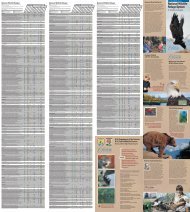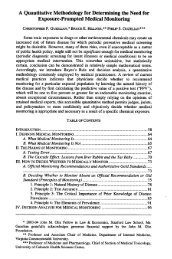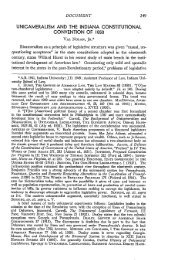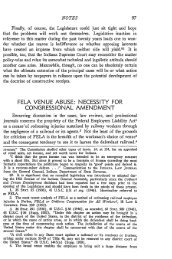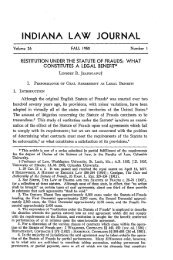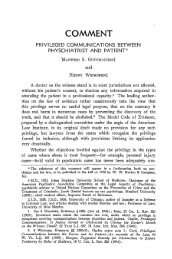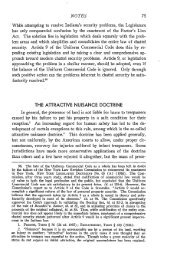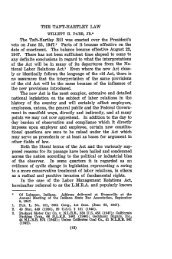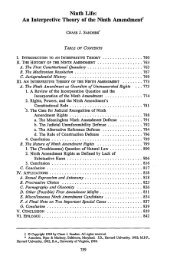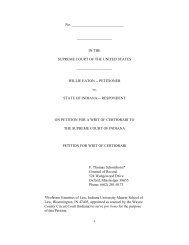Test of Causation Between Employment and Injury - Indiana Law ...
Test of Causation Between Employment and Injury - Indiana Law ...
Test of Causation Between Employment and Injury - Indiana Law ...
Create successful ePaper yourself
Turn your PDF publications into a flip-book with our unique Google optimized e-Paper software.
19491<br />
RECENT CASES<br />
worknen's compensation cases in 1940,13 it has not passed on<br />
any cases involving an act <strong>of</strong> God. But the court has been<br />
liberal in its interpretation <strong>of</strong> the compensation laws. 14 It<br />
is therefore surprising that the Supreme Court should repudiate<br />
the lenient test advanced by the lower court <strong>and</strong><br />
adopt the increased risk type test for causation. 1 5 The higher<br />
court attempted to reconcile the conflicting decisions in cases<br />
involving lightning <strong>and</strong> other acts <strong>of</strong> God by stating that<br />
the decisions <strong>of</strong> the Industrial Board have always been upheld<br />
when supported by any probative evidence. The court<br />
decided that any lack <strong>of</strong> consistency may be attributed to<br />
factual variations <strong>and</strong> the inevitable effect <strong>of</strong> sympathy for<br />
injured employees <strong>and</strong> their dependents.16<br />
For two reasons the Supreme Court's reliance on the<br />
increased risk test seems unfortunate. Entirely aside from<br />
the question <strong>of</strong> the intrinsic merit <strong>of</strong> that test, it has been<br />
productive <strong>of</strong> nothing but confusion. Particularly in cases<br />
<strong>of</strong> injury by lightning, where every holding has had its opposite,'1<br />
the difficulty <strong>of</strong> applying the test with certainty is<br />
13. Warren v. <strong>Indiana</strong> Telephone Co., 217 Ind. 93, 26 N. E.2d 399<br />
(1940).<br />
14. See, e.g., Patton Park Inc. v. Anderson, 222 Ind. 448, 53 N.<br />
E.2d 771 (1944), where a compensation award was affirmed despite<br />
objection that the workman was not under the control <strong>and</strong> supervision<br />
<strong>of</strong> the employer's agent. Evidence to the contrary was objected to by<br />
the employer as hearsay, but the court found that there was control<br />
<strong>and</strong> declared that strict rules <strong>of</strong> evidence did not apply to the proceedings<br />
before the Industrial Board, which procedure the statute<br />
provided shall be as summary <strong>and</strong> simple as reasonably possible. And<br />
in Soetje & Arnold, Inc. v. Basney, 218 Ind. 538, 34 N. E.2d 26 (1941),<br />
the court declared that in determining whether the finding <strong>of</strong> the<br />
Board was supported by the evidence, any evidence unfavorable to the<br />
finding must be disregarded <strong>and</strong> only favorable <strong>and</strong> reasonable inferences<br />
therefrom should be considered.<br />
15. The court cited <strong>and</strong> apparently approved Deckard v. Trustees<br />
<strong>of</strong> <strong>Indiana</strong> University, 92 Ind. App. 192, 172 N. E. 547 (1931), a case<br />
overruled by the Appellate Court in this case, <strong>and</strong> Illinois Country<br />
Club, Inc. v. Industrial Comm'n, 387 Ill. 484, 56 N. E.2d 786 (1944),<br />
a case in which the Illinois Court reversed an award for injuries sustained<br />
when a caddy was struck by lightning while st<strong>and</strong>ing under a<br />
tree in wet clothes <strong>and</strong> carrying two bags <strong>of</strong> metal golf clubs.<br />
16. Cf. Wells v. Robinson Const. Co., 52 Idaho 562, 16 P.2d 1059<br />
(1932); Illinois Country Club, Inc. v. Industrial Comm'n, 387 Ill. 484,<br />
56 N. E.2d 786 (1944); Mincey v. Dultmeir Mfg. Co., 223 Iowa 252,<br />
272 N. W. 430 (1937) (which indicate an endeavor to keep the burden<br />
<strong>of</strong>f the employer).<br />
17. A review <strong>of</strong> the lightning cases shows the diversity <strong>of</strong> results<br />
obtained from application <strong>of</strong> the increased risk formula. See Note, 26<br />
MicH. L. REv. 422 (1927); Note, 83 A. L. R. 235 (1933). In one <strong>of</strong><br />
the first American cases <strong>of</strong> injury by lightning, the court held that<br />
a workman who took shelter under a tree was subjected to an increased<br />
risk which established causal connection. State ex rel. People's Coal



